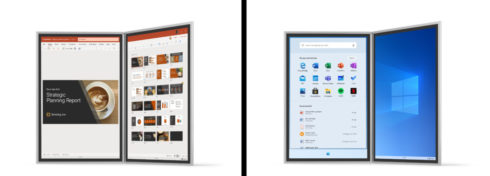
When Samsung first released its foldable phone model earlier this year, things didn’t go as planned. Users reported that the top layer of the screen, which looked like a screen protector, peeled off easily, damaging the display.
Even after extensive testing by robots, Samsung had failed to test what use would actually look like when in a human’s hands, which is what caused this launch failure. Months later, the company fixed some of the early issues and was ready for a relaunch. Now, Microsoft is trying to corner a piece of the foldable device market.
The company recently announced its holiday lineup of five new Surface devices, and then announced that in the 2020 holiday season, it would release two dual-screen Surface devices, Surface Neo and Surface Duo, as well as a new operating system to support foldable screens.
Unlike the Samsung Galaxy Fold, which had a single screen that folded in the middle, the two new Surface devices have two separate, equally-sized displays. But the screens still have a continuous display, producing the same effect, just with a gap in the middle where the two screens meet.
RELATED CONTENT:
Foldable technology will force developers to think outside the box
The coming mobile disruption
The Surface Neo has two 9” screens that unfold into a 13” display. Surface Duo is pocket-sized, with two 5.6” screen that will unfold into an 8.3” screen.
“With Surface Neo and Surface Duo we are introducing a new category of dual-screen devices designed to help people get more done on smaller, more mobile form factors. Today, people carry PCs, tablets and phones because each device performs a specific task well. Each screen does something we need when we need it. But these devices are limited with what they can achieve when you must switch between apps on a single screen or switch between screens altogether. When that switching happens, we break our focus. We break our flow,” Microsoft wrote in a post.
To support Surface Neo and Surface Duo, Microsoft is introducing Windows 10X. Windows 10X is an extension of Windows 10 that is designed for dual-screen PCs, the company explained.
Windows 10 users will be able to use Windows 10X with almost no learning curve. According to Microsoft, Windows 10X will have similar navigation and functionality to Windows 10.
In addition, the new operating system includes core enhancements to the technology to optimize it for more flexible postures and mobile use. This includes improving battery life to power two screens instead of one, hardware performance, and compatibility. “Windows 10X is the best of Windows 10 built to enable unique experiences on multi-posture dual-screen PCs. We have taken the Windows 10 that customers know and love and built Windows 10X in a way that marries the familiar with the new,” Microsoft wrote in a post.
Windows 10X will roll out in fall 2020 on dual-screen and foldable devices, such as the two upcoming Microsoft Surfaces and devices from ASUS, Dell, HP, and Lenovo. Microsoft added that Windows 10X is not an OS upgrade for Windows 10 users, but is designed specifically for these types of devices.




